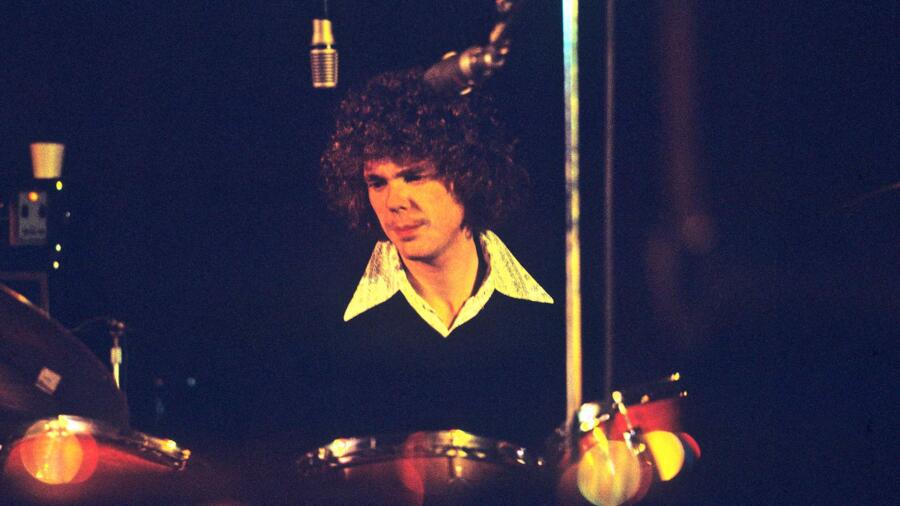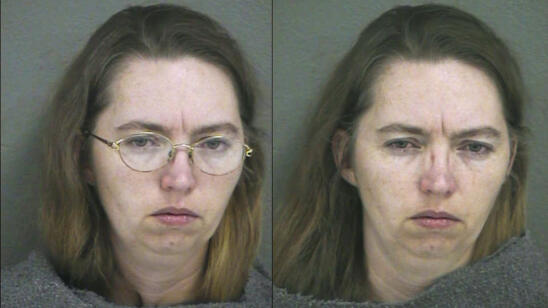Jim Gordon is best known as the drummer for Eric Clapton’s band Derek and the Dominos. However, he also saw success in the 1960s and ‘70s with the Mamas and the Papas, Everly Brothers, Frank Zappa and Alice Cooper. Drums provided a necessary refuge for Gordon, who was fighting a private—and losing—battle with undiagnosed schizophrenia.
“The drums were his face to the world. As long as he could play drums, he was alright,” writes music journalist Joel Selvin.
Gordon’s mental decline was gradual. He went from mumbling to himself during recording sessions to violently beating his second wife Renee Armand and choking a girlfriend as she slept. The incidents, fueled by paranoia, shocked both Gordon and his victims.
Gordon was in and out of hospitals while medicating with drugs and alcohol. His delusions became more grandiose and debilitating—with him blaming his mother, Osa, for the deaths of comedian and actor Paul Lynde and singer Karen Carpenter.
[Stream episodes of The First 48 in the A&E app.]
Gordon was erased from the rock lexicon on June 8, 1983, when he beat his mother with a hammer at her home and fatally stabbed her. The grisly crime scene was discovered after a neighbor heard screams and called 911.
Selvin says the slaying occurred amid a psychotic break.
Gordon was serving 16 years to life for his mother’s murder when he and Clapton won a Grammy for “Layla.” His achievement went uncelebrated.
“[Gordon] is one of the greatest drummers in rock. Not just his ability, the records he played on— not just ‘Layla.’ He played on ‘Good Vibrations’ by the Beach Boys, ‘Wichita Lineman’ by Glen Campbell and all Merle Haggard’s hits,” Selvin says. “That contribution vanished as soon as he went to jail.”
In March 2023, Gordon, age 77, died at a prison medical facility in Vacaville, California.
Selvin, author of Drums & Demons: The Tragic Journey of Jim Gordon, spoke with A&E True Crime about the mental health issues that derailed Gordon’s life and career.
How did Gordon’s drumming provide refuge from the voices he was hearing? How did his mental health come at direct odds with his career?
Drums muted the voices, between the rhythmic entrainment, the hypnotic power of the mighty groove and the report of striking the drum—which you feel in every cell of your body. It consumed his consciousness and erased the voices. It put him in the world of rhythm, and he was a master.
The voices in Jim’s head didn’t like him playing music. They controlled him in terms of eating and sleeping. Jim’s reality was an entirely different thing. Those voices controlled him through extremely painful headaches and frustrated Jim in his efforts to lead a normal, productive, creative life.
How did the ‘mask’ Gordon wore for the world start to fade?
Jim’s interior life was so turbulent and poisonous that the one way he could operate was to suppress that and act in a certain way. He had a very compliant, genial and almost bullish type demeanor which he relied on to get through social situations. He’s schizophrenic—he had no empathy or ability to bond with other people.
It made his life a complete hell when he wasn’t playing drums. He had to navigate himself to that place where he could do what he [did] well and operate and function as a complete human being. Without that, he was floating in a mass of indecision, guilt and doubt…of all these negative emotions that clouded his whole being.
Before the murder, Gordon sought psychiatric help and went to Alcoholics Anonymous, but he wasn’t adequately treated. How did that exacerbate his issues?
Jim saw plenty of psychiatrists and took all the medicine they gave him. Back in the ’70s, that stuff was…vicious antipsychotics and tranquilizers that weren’t very effective. Neither was shock therapy or the psychiatric residential treatment programs he entered. The only thing that worked for him was drinking and using cocaine—it could quell the voices.
In the mid-70s, the recovery community was just learning about what they now call dual diagnosis, [which is] a combination of organic mental illness and drug and alcohol addiction that are bathed together in a very toxic way. It’s difficult to treat one without treating the other. The recovery community didn’t know what to do with people who were mentally ill, and the psychiatrists dealing with mentally ill people were not versed in alcohol and drug recovery. Jim could afford all the best care available, but it didn’t amount to much.
How did those close to Gordon process his increasingly concerning behavior?
They never did. Jim was hiding his illness. When it had gotten so severe that he couldn’t play or do sessions anymore, he would mention it to people who were especially close to him. They didn’t understand it.
There were unexplained episodes and people just went, ‘Huh, what was that?’—starting with him punching his girlfriend [and singer] Rita Coolidge in a hotel hallway during [Joe Cocker’s] “Mad Dogs and Englishmen” tour. There were later episodes in recording studios where Jim burst into arguments with people who weren’t there. It freaked people out. There’s no shortage of irony in the ’70s rock scene; it was very hospitable to alcoholics, sexual deviants, wife-beaters and all kinds of terrible behavior. But they didn’t know what to do with someone who was mentally ill.
What role did Gordon’s mother, Osa, play in his hallucinations? How did her concern for Gordon motivate his murderous actions?
Jim said he was crowded with voices, but the chief one was his mother. It was a very controlling, cynical, harsh voice. In real life, his mother was kind and warm but also a bit controlling. She was a maternity nurse and her husband, Jim’s father, went into Alcoholics Anonymous in 1958 when Jim was 14. She was very active in the recovery community but had no understanding of what was going on with Jim.
Jim would be over and not eating at dinner because the voice in his head was telling him not to eat. [Meanwhile,] his mother was outside his head, wondering, What’s the matter? Don’t you want to eat? Aren’t you hungry? In his mind, Jim was thinking that this was just another one of his mother’s games. He had focused on his mother as a figure of evil in his mind.
As a schizophrenic, Jim had no concept of how to be a father. That was a subject of frustration for him. His mother lived nearby and was very close to his daughter Amy and [his first ex-wife] Jill [Barabe]. [Osa] managed Jim’s access to her, so that he would go to her house to see Amy or pick her up. But that was the sort of control put in place to manage Jim’s relationship with his daughter. He saw that as Osa controlling him, and he developed some resentment around that.
What were the events leading up to the murder? Did Gordon’s mother ever alert law enforcement?
The idea was presented to him by Osa’s voice—You’ll just have to kill me. It led to an intense mental condition where he repeated the thoughts over again. [The next day,] he went to Osa’s, but she wasn’t home. So he went back that night. She returned from dinner and an [Alcoholics Anonymous] meeting around 11 o’clock. He killed her right away. He struck her with a hammer, knocking her to the ground. He stabbed her through the heart—several times.
You explain that Joel Osmond, drummer for the Osmond Brothers, was the only person to vouch for Gordon in court. How did Gordon’s family react to the murder?
The minute Jim was arrested, the entire world turned their back on him. [The murder] came out of nowhere to the rest of the world who did not know anything about Jim’s mental illness.
His family was traumatized tremendously. His older brother called for his execution. His daughter would not answer any of his letters to her. Nobody came to visit him in jail. When he went to court, the only person who showed up was Osmond, who played with Jim at a Vegas gig in the ’60s.
Do you believe the murder could’ve been prevented if Gordon was properly diagnosed?
Schizophrenia is very difficult to treat [despite it being] super common among the general population. Schizophrenia affects one in 100 people. Half of people with schizophrenia don’t respond to treatment at all. The other half are on a sliding scale: Some can lead fully productive lives [while others] are heavily medicated and struggle with it every day but manage to stay between the gutters.
Jim’s schizophrenia wasn’t diagnosed [before the murder] because he was too high-functioning. He was carrying a professional career and making a lot of money. [Doctors] thought he was depressive. He had drug and alcohol problems and maybe a mood disorder. He was not diagnosed with schizophrenia until after the crime.
What was Gordon’s family’s reaction to his death?
When I first started to work on the book…[Gordon’s friends and family] were open to talk about the pain and confusion of having Jim as a father, ex-husband or friend. It wasn’t resolved by him being in prison, but it was resolved by him dying.
Immediately after his death, there was an entire change of attitude in the world. No longer was Jim this guy who killed his mother; he was somebody who had been severely mentally ill. He started to get a bit of the compassion that he had never received before. Jim had to die to be forgiven.
Related Features:
Billy Milligan: Can Someone With Dissociative Identity Disorder Be Accountable for Violent Crimes?
Ed Gein: The Skin-Suit-Wearing Serial Killer Who Inspired Psycho’s Norman Bates


